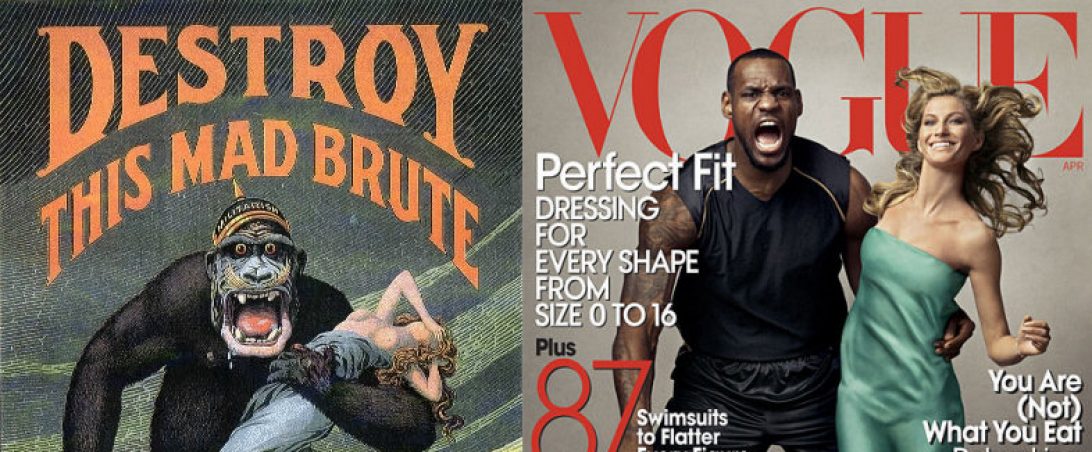In an article called, “Small Change,” the author Malcolm Gladwell explores the concept of how humans use today’s media to give voice to social issues we are facing. Malcolm Gladw ell states, “The new tools of social media have reinvented social activism.” With Facebook and Twitter, traditional relationship between political authority and social justice became more visible to the public eye. In the articles, Malcolm Gladwell states, “The platforms of social media are build around weak ties. Twitter is a way of following (or being followed by) people you may never have met. Facebook is a tool for efficiently managing your acquaintances, for keeping up with the people you would not otherwise be able to stay in touch with.” Social media is a medium for fast and easy connection. It allows people to connect with others, share information, and compare ideas. This accessibility is the main foundation for public protest and to spared social issues to the public. For example, I am apart off an organization called, Filipino American Student Association (FASA), we use social media to inform the public such as students in and out of our University, members in other FASA organizations in the Northwest, and supporters. We use this new tool to connect with other people and to share the inequalities we see in our educational and public settings due to our skin color. Social media became a tool of power. Another example of how social media builds a strong foundation of public protest, the FASA organization are easily able to host events, shared social change, and to connect and gather individuals for a cause. The Northwest FASA just hosted a convention to bring Filipino and all students alike to learn and bring importance to the Filipino culture. This convention allowed Filipino American college students to see the social changes Filipinos face outside the educational setting.
ell states, “The new tools of social media have reinvented social activism.” With Facebook and Twitter, traditional relationship between political authority and social justice became more visible to the public eye. In the articles, Malcolm Gladwell states, “The platforms of social media are build around weak ties. Twitter is a way of following (or being followed by) people you may never have met. Facebook is a tool for efficiently managing your acquaintances, for keeping up with the people you would not otherwise be able to stay in touch with.” Social media is a medium for fast and easy connection. It allows people to connect with others, share information, and compare ideas. This accessibility is the main foundation for public protest and to spared social issues to the public. For example, I am apart off an organization called, Filipino American Student Association (FASA), we use social media to inform the public such as students in and out of our University, members in other FASA organizations in the Northwest, and supporters. We use this new tool to connect with other people and to share the inequalities we see in our educational and public settings due to our skin color. Social media became a tool of power. Another example of how social media builds a strong foundation of public protest, the FASA organization are easily able to host events, shared social change, and to connect and gather individuals for a cause. The Northwest FASA just hosted a convention to bring Filipino and all students alike to learn and bring importance to the Filipino culture. This convention allowed Filipino American college students to see the social changes Filipinos face outside the educational setting.
Uncategorized
Music Industry: Advertising and Marketing Nowadays
When all the music apps took over the cassette, vinyl and CD-s they didn’t only changed the way we listen music but how we consume music in entire. From the way the music is being produced, distributed or sold also the way the musicians advertise and sale their talent. In the early years of the actual decade, the revolution of social media was arguably the biggest one, since TV was invented. The transformations in popular music production and consumption made possible by internet technology go beyond merely the selling and buying of records, however, with the nature of popular music stardom itself changing under the influence of advanced branding and marketing techniques (The 360 deal and the “new” music industry, 2013).
All the millennials are part of it and everyone owns a smartphone and a gadget that can provide access to internet. It became a way of life since apps like Facebook, Twitter, Instagram etc. lead the way to this technological revolution. Also from this revolution many other ways of doing things in music has changed. How we listen music has changed also. “Nearly two thirds of the 3,000 young people polled by Nielsen said they use YouTube, Google’s video streaming site, to listen to songs. Although the service does not specialize in music, its vast library of user-uploaded tracks – for which YouTube has several licensing deals – makes it a popular alternative to music services such as Spotify and Rdio” (YouTube is teens first choice for music, 2012).
It’s more than enough to have on your phone an app like Spotify, Apple Music or YouTube combined with an subscription and an internet connection to listen whatever you want, whenever you want. You don’t have to have a full shelf of CD-s to go through to choose, but with the touch of one finger you can navigate the classic and modern music without worrying to change CD-s or Vinyl’s. A virtual library is on the palm of your hand. You can listen, like and share. Feedback in real time, with your friends with the fans, with the record companies and the artists all around the world.
This feedback is one reason why the artists changed the way they have to advertise their work. The singers/bands keep posting stuff about their music, their upcoming song, album or tour. And they get the likes and the dislikes in matter of seconds. The fans can react in the same moment. It’s now difficult to find a society, culture or set of human relations that are outside of the reach of the media (Carah & Louw, 45). That said with this revolution comes also the way artists, discographic studios and music managers advertise and choose the markets they want to break in. Now the musicians can choose to livestream in any platform or internet page, or social media account to play live their whole concert or parts of it. Just few weeks ago the British indie-rock band, Muse streamed on line in their Facebook page a whole live concert in Paris. And not only! The fans were choosing in real time which songs to play next. They had few choices and by fan vote they were playing the song with the most votes. Something that 15-20 years ago wasn’t imagined at all.
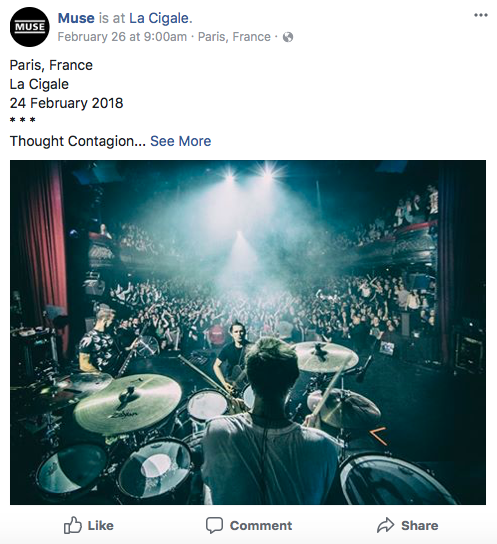
Figure 1. The British band Muse streaming live from Facebook
In the same way new artists can advertise themselves in YouTube, the popular video stream giant owned by Google. All you need is a smartphone and an account on YouTube, record yourself, upload on YouTube and here you go: You got your single out for everyone to check and judge on your talent. The same way to do it also is used by already affirmed artists. When they choose to advertise an upcoming video or single they use all the social media accounts and a fan don’t have to turn the TV channel on MTV (Music Television channel, so popular in eighties-nighties), all they have to follow from any location is the artist page on YouTube, Facebook, Twitter, etc.
Many of the singers and bands have an official profile on social media and many of them also manage personally the account. They chose to advertise their work trying to tease new pictures and videos from the studio where they are recording, keeping their fans updated but at the same time creating a suspense atmosphere so the upcoming work looks much more intriguing than it might be. In this way they skip another link from the chain which might be the critics evaluation of their new album. So no matter the word of experts, they put their work already in the market.
One thing is that many of the old school bands which suggested that this new idea of advertising and selling music is not the proper way, they are joining the crowd also. One big example is the heavy metal band Metallica. The rock veterans and their drummer Lars Ulrich were one of the loudest voices against the Napster the genesis of websites and servers, used for sharing the music online for free. But in an interview published in Rolling Stone magazine Ulrich reflects about that time. The drummer thinks that he wasn’t necessary wrong but it kind of embraced the change since he couldn’t stop it. “We underestimated what it meant for people in sense of freedom”, Ulrich said (Metallica’s Lars Ulrich, What he learned from Napster Battle, 2016).
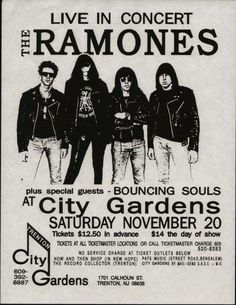
Figure 2. An old style concert poster from the band Ramones
To conclude, the change in music industry advertising is not necessarily good or bad, but in terms of convenience, fast feedback and popularity and considering the rise not only of the social media but media in general is much better than before. Not only for the artists and producers but for the fans also, which are the consumers and have their say in this matter.
G.K.
Peer Edited By: X.Z & M.R.
Works Cited
Grow, Kory. “Lars Ulrich on Metallica’s Darkest Times, What Napster Battle Taught Him.”
Rolling Stone, Rolling Stone, 7 Nov. 2016, www.rollingstone.com/music/features/lars-ulrich-on-metallicas-darkest-times-napster-battle-w448546.
Louw, Eric. “The Industrial Production of Meaning .” Media e Society: Production, Content and Partecipation, by Nicholas Carah, First ed., Sage, 2015, pp. 45–46.
Marshall, Lee. “The 360 deal and the ‘new’ music industry. ”European Journal of
Cultural Studies Vol 16, Issue 1, pp. 77 – 99First Published January 21, 2013 https://doi-org.offcampus.lib.washington.edu/10.1177/1367549412457478
Michaels, Sean. “YouTube Is Teens’ First Choice for Music.” The Guardian, Guardian News
and Media, 16 Aug. 2012, www.theguardian.com/music/2012/aug/16/youtube-teens-first-choice-music.
Muse. “Live from Cigale Paris 2018”. Facebook, 24 Feb. 2018, 9:00 a.m., https://www.facebook.com/muse/. Accessed 07 March 2018.
Women In Advertising: Suggested Reading List
Here, we have compiled a list of scholarly and non-scholarly sources of information that have helped us truly understand the nature of “Women in Advertising” and why.
07, 2017 Nicola Kemp March, and How long? 1 minute. “Six Stereotypes of Women in Advertising.” Campaign: Marketing, Advertising and Media News & Analysis, 4 Mar. 2017, www.campaignlive.co.uk/article/six-stereotypes-women-advertising/1426391.
This article is a non scholarly article published in 2017 that explains the six stereotypes of women in advertising, which are; domestic obsessive, selfless nurturer, sex object, unattainable goddess, the fraught juggler, and the bit part. This article will be helpful to our group project because it will help categorize how women themselves are categorized in advertising. Since we have a focus on women, I think it’s first important to see how we are stereotyped and then with the other sources see what why we are stereotyped that way. This article is just a basic summary of a bigger project.
(Annotation provided by Cheryl)
Rogers, Charlotte, et al. “Just 19% of People in Ads Are from Minority Groups.” Marketing Week, 30 Jan. 2017, www.marketingweek.com/2016/12/06/lloyds-diversity-report/.
This article is a non scholarly article published in 2017 that explains the small amount of representation in ads from minority groups. There is only 19% of people who are minorities in ads even though 65% of people would feel more favorable about a brand that promotes diversity. They also compare advertisements that do include more minority groups and those that don’t. I think this article is helpful because although it’s mainly centered in the UK, it still has the same concepts for the US because minorities are still a small part in advertisements here. And because it’s so recent I think it will help us have a more recent perspective to compare with older ones.
(Annotation provided by Cheryl)
Brown, Stephen W., et al. “The Portrayal of Women in Advertising: An Overlooked Area of Societal Marketing.” Journal of the Academy of Marketing Science, vol. 4, no. 3, 1976, pp. 577–583., doi:10.1007/bf02729770.
This article is a scholarly source published in 1976, it is about the “feminist complaints” on female image in advertisements. It explains the stereotypes included in advertisements and the message it sends to the public. Lastly, it is meant for a framework for future research on the female image. This article is a little older at a time where women were still subjected to the objectification and stereotypes of the damsel in distress, so I think it’s still important to compare how women back then and women back now were like and if anythings change. I think it’s apparent that the sexism is very much alive because of how they said “feminist complaints” so the progress that was made is good to compare.
(Annotation provided by Cheryl)
Kim, Minjeong, and Sharron J. Lennon. “Content Analysis of Diet Advertisements: A Cross-National Comparison of Korean and U.S. Women’s Magazines.” Clothing and Textiles Research Journal, vol. 24, no. 4, 2006, pp. 345–362., doi:10.1177/0887302×06293029.
This article is a scholarly source published in 2006. It is essentially comparing the western ideal of beauty and how that affects Korean women’s magazines compared to U.S. women’s magazines. What the article concluded was that, the western ideal had a very big impact on Korean’s. This article unlike the others focuses more on minorities and the effect that western beauty advertising has on other cultures. It’s a lot different because it’s not necessarily about the stereotypes but the why and the effects of these images of women in advertising themselves. Which will be helpful because it’s important to cover all bases of how women in advertising affect people all around the world.
(Annotation provided by Cheryl)
Crockett, David. “Marketing Blackness.” Journal of Consumer Culture, vol. 8, no. 2, 2008, pp. 245–268., doi:10.1177/1469540508090088.
In this article, David Crockett discusses how ideas of blackness, black culture and traits like common ways of speaking, hairstyles, style of dress, music and looks are used and manipulated to market products and services. Through analyzation of data we notice similar themes and signifiers used to create a sense of relatable identity with the black viewer. Often we see that the product is advertised as a key part of the black experience and necessary for the needs of a black person and not just for anyone. Crockett goes onto say that we need more critical research done on the impacts of advertising to black people and on the way we market black people to see if there are any possible negative impacts. I would say Crockett gives a thorough evaluation of blackness and the black identity through advertising considering the limited information that can be found. In my personal experience, I do believe his claims to be true and have found similar themes in advertising without making the connections he had.
(Annotation provided by Medaine)
Woodard, Jennifer Bailey, and Teresa Mastin. “Black Womanhood: Essence and Its Treatment of Stereotypical Images of Black Women.” Journal of Black Studies, vol. 36, no. 2, 2005, pp. 264–281., doi:10.1177/0021934704273152.
In this article, Jennifer Bailey Woodard and Teresa Mastin closely examine the portrayal of black women in the magazine “Essence”, marketed as a “Black women’s lifestyle guide for the latest in fashion trends, black hair, love & sex advice.” and whether the magazine “works as a liberating feminist text that dispels, as opposed to validates, stereotypical images of Black women.” They do this by examining their uses of four common stereotypes or archetypes of black women; mammy, matriarch, sexual siren, and welfare mother or queen. They conclude that through their work its found that yes, the magazine aims at dispelling these stereotypes and have significantly reduced the portrayal or adressing of these roles as times have changed, like “mammy” and “welfare mother/queen” but have difficulty straying away from the “sexual siren” and “matriarch” persona in their writing as of today. I believe Woodard and Mastin’s claims to be true. Although the magazine aims to stop these stereotypes they still cannot help but follow the less “out-dated” ones as they are so deeply ingrained in the identity of what makes a black women, not only in advertising but in the everyday experience.
(Annotation provided by Medaine)
Barletta, Marti. Marketing to women: How to understand, reach, and increase your share of the world’s largest market segment. Dearborn Trade Publishing, 2003.
This book, written by marketing expert Martha Barletta, effectively discuss the problem of companies do not aware the power of woman buyer. She uses a compelling business case to illustration the discipline of the marketing professionals of men and women. Meanwhile, how women reach more purchase than men, and the marketing plan created targets women, are discussed in detail. I found this book useful because much of the content of the studies can be easily accommodated to fit the group project of marketing and women.
(Annotation provided by Bing)
Seligmann, Linda J. Women traders in cross-cultural perspective: Mediating identities, marketing wares. Stanford University Press, 2001.
In this book of studies women as language, economic, political, and value in informal market. Linda analyze the global influence of women in economic and political activities. The research also led to a new hypothesis of women in market impact social movement. I use this book as resource because it not only presents the relationship between women and market, but also give more information in different area, which will be more reliable the research of the group project of marketing and women.
(Annotation provided by Bing)
Simpson, Jack. “17 marketing campaigns with a positive message for women.” Econsultancy, 8 Mar. 2016, econsultancy.com/blog/67626-17-marketing-campaigns-with-a-positive-message-for-women.
This article, Jack Simpson summaries the post wrote by Chloe McKenna about social media campaigns that celebrate women. He chooses to highlight seventeen other marketing campaigns he has seen that depict a positive message about women. The article is interesting describe the relation between women and marketing, which like bring a fresh air for the research with different point of view of the project topic.
(Annotation provided by Bing)
Tilearcio, Tatiana. “Wonder Woman Inspired: The Leading Women in Marketing.” Synthesio, 11 July 2017, www.synthesio.com/blog/wonder-woman-marketing/ (Links to an external site.)Links to an external site..
Tatiana Tilearcio metaphor the leading marketing women as “Wonder Woman”, and give a list of some top name in the industry, and brief the label of each one. The article seems to be very simple, but with list of marketing legend women list. I could explore more after for the group project of marketing and women.
(Annotation provided by Bing)
Suggett, Paul. “The Objectification of Women in Advertising.” The Balance, www.thebalance.com/advertising-women-and-objectification-38754.
The article was written December 21st, 2016. This was quite recent and hopefully should still be relevant. It is more of a think-piece and it was written as an examination of women in the marketing/advertising industry. How their body image is constructed towards benefiting the male gaze through ads and how impossible standards translate to human desire on a superficial scale.
(Annotation provided by Brandon)
“Women: Representations in Advertising.” Ad Age, 15 Sept. 2003, adage.com/article/adage-encyclopedia/women-representations-advertising/98938/.
This piece was written in September, 2003. It focuses more on the historical landmarks of women in advertising and how the role of women in ads have changed. Since it is from a website called “AdAge” they focus less on the social justice aspects of women in advertising and more the cultural impact that women had on ads and vice versa.
(Annotation provided by Brandon)
Nielson, Hailey E. “Dove Campaign for Real Beauty.” Eating Disorders: An Encyclopedia of Causes, Treatment, and Prevention, edited by Justine J. Reel, Greenwood, 2013, pp. 147-149. Gale Virtual Reference Library, http://link.galegroup.com/apps/doc/CX2723200058/GVRL?u=wash_main&sid=GVRL&xid=d5bfeed8. Accessed 25 Feb. 2018.
This article by Hailey Nielson in 2013 looks at the Dove Campaign for Real Beauty and how it challenged the typical depiction of women in beauty products. It challenged that and it also just challenged the idea of what beauty is. It looked at body dysmorphia, it looked at all shapes, all sizes, all races, basically provided a spectrum of women to provide greater inclusion.
(Annotation provided by Brandon)
Matthes, Jörg, et al. Sex Roles, Springer US, 2016, www.ncbi.nlm.nih.gov/pmc/articles/PMC5023740/.
This source breaks down the stereotypes in print and visual media of both men and women as comparisons to the pitfalls of advertising. This article was written by Jorge Matthes and Michael Prieler on April 5th, 2016. It speaks on how these stereotypes were built and how their construction affects the way an audience perceives what they are selling. Why sex sells and why it works.
(Annotation provided by Brandon)
Teri Del, Rosso (2017) “There’s a cream for that: A textual analysis of beauty and body-related advertisements aimed at middle-aged women”, Journal of Women & Aging, 29:2, 185-197, DOI: 10.1080/08952841.2015.1125698n
This is a scholar article published in 2016 by Teri del Rosso. It has four sections talks about: aging studies, media and beauty/body ideals, advertising and age and advertising and body image. I thought this article would be helpful in understanding the strategies behind women advertisement. Particular in aging and body image. For example, how advertisers often pathologize aging and how they use model that is younger then targeted women’s age, also how advertisers force women into feeling dissatisfaction in their body. Moreover, it also talks about how advertiser create a hegemonic beauty and how it establishes an idealized version of women.
(Annotation provided Demi)
Reissman, Hailey. “Spotlight TEDx Talk: The Dangerous Ways Ads See Women.” TEDx Innovations Blog, 28 May 2015, tedxinnovations.ted.com/2015/05/27/spotlight-tedx-talk-the-dangerous-ways-ads-see-women/.
This is a 2014 TEDx talk by Jean Kilbourne. She is a researcher on advertising within the context of gender and culture. In this video, it gives a lot of example and talks about how normal women in ads is portray in a more feminize and sexual way. Even though guys are being objectified more than it used to be, but it’s not the same as women and girls being objectifies. When women are being objectifies there are some degree of dangers that come with it because of gender and culture difference. And nowadays even little girls are sexualized in ads. I thought this video gave us a general idea and evidences on how women are portrayed in advertising.
(Annotation provided Demi)
Digital labor and social media: The Hidden ability of “Like”
Social networking sites(SNSs) are turning into an undeniably standardized part of individuals day by day social lives. It is such an innovative technology that makes it possible for all individuals to receive a piece of information quickly and to communicate with other people as quickly possible (Sahin,2017). Based on Carah and Louw, “social media are embedded within interactive digital networks. It comprises the whole range of internet technologies that collect, organize, and circulate information. It also allows the users to create and explore content within social networks (Carah&Louw 2015.)” With the features that the internet provides, it has been an instrument of communication infiltrate every single human in this universe. Internet in the modern day is a prominent instrument used and enjoyed by not only adults, youngsters but also children(Sahin,2017). Social network sites (SNSs) such as such as Instagram, Twitter and Weibo allow an individual to portray themselves, express their social networks, and create or keeping in touch with others.

Pic From: https://solik-help.com/2015/09/24/social-media-definition-usage-and-tips/
These sites can be intended towards work-related fields (LinkedIn.com), romantic relationship initiation (Tinder), engaging those with common interests such as music or politics (Twitter.com), or connecting students with other students or instructors like Facebook and Gmail (Ellison, Stainfield, Lampe, 2007.) Carah and Louw believes that “social media that is developing around is one that not only supplies greater opportunities to create and circulate information, it will also be more intuitively applied to our daily life(Carah&Louw,2015.)” For instance, the usage of social media as your source of income and the company’s walking billboard. Hou also supported the fact that “the institutionalization of social media platforms like YouTube and the professionalization of amateur content creation may lead to social media becoming a new locale for industrialized celebrity manufacturing (Hou,2018.)”

Credit: Pinterest
Connecting to social media, Digital labor is one of the crucial parts of this argument. This paper manages the inquiries: What is digital labor? What is digital work? Digital labor is “a hypothesis that has become a decisive foundation of discussions within the land of the political economy of the Internet ( Burston, Dyer-Witheford and Hearn 2010; Fuchs and Dyer-Witheford 2013; Scholz 2012).” Fuchs describes that “the main argument in this paper is that the overwhelming capital aggregation model of contemporary corporate Internet platforms is based on the harshness of unpaid labour, who engage in the creation of content and the use of blogs, social networking sites, wikis, microblogs, content sharing sites for fun and in these activities create value that is at the heart of profit generation (Fuchs 2010).” He also believes that “online activity creates the connection, social networks, and relations, location data, browsing data, data about likes and preferences, etc.(Fuchs,2010.)”
This paragraph of the case study will be discussing the documentary written by Koughan and Rushoff called “Generation Like.” The plot of the documentary is all about American young adults in exploring their curiosity about the tricky connection between teenagers and the huge corporate brands that are constantly working to target them. (Rushoff.,2014.) Based on Montclair High School students, they are putting themselves looking good on their social platform because for everyone to see. With their perspective and usage of social media, “corporations were chasing them down, taking their culture and selling back then (Rushoff,2014.)” Which means that the corporation is using them as the marketer of their product because they believe that a commercial is a tool that can change into money.
Watch: Generation Like
Rushkoff believes that “innocent teens who have replaced the habit of putting up their favorite band or film posters on their bedroom walls now occupy the digital space in droves, and most of them have no idea just how much their Facebook shares and retweets are benefiting the biggest brands out there.(Washeck,2014.)” The best example that I can offer is Tyler Oakley, he started to make a YouTube video for fun. By making the video just about his opinions about his idols, he got millions of like, comments and followers that led him into a superstar. The other popular trend is online beauty guru like Bretman Rock, he surpassed more than 9 million followers on Instagram, 2.7 million subscribers on Youtube and the most important thing is that he has been sponsored more than 10 popular brands on his videos. Can you imagine that several of his youtube video post can afford him to buy a house at the age of 18?




The very first point on how digital labor can change a person’s life as fast as a speed of light is because “companies know how to change into money (Rushoff,2014.)” Maybe elderly and probably some adult did not know how digital media are so powerful right now, but they need to know that their kids or grandchildren are indirectly contaminated with that vibe where society do everything to grab other human’s attention. For instance, “when a kid like something, they become who they are(Rushoff,2014.)” They will do anything to get what they aim for, for example like making a video about your daily life, commenting about your idols or something that has been bothering to.
Since young adult tends to outstand themselves comparing to adult, big companies are targeting them as one of their walking billboards. Karl Marx gave an biological property of work which in the German Ideology, Marx and Engels (1845/46, 37) insist that “work is a conscious productive activity that transforms and organises nature so that humans “produce their means of subsistence” in order to satisfy human needs, which constitutes “the production of material life itself. (Fuchs,2013.)””
“Social media celebrity is the best current example of distinction in the arranged society, distinguished by a new cultural logic distinguishing it from the traditional celebrity. (Hou,2018.)” Many social network celebrities decided to stay keep in touch and building a good relationship between them and the subscribers because audience’s enthusiastic is one of the keys to a success of the celebrity. But at the end of the day, the marketing of brand through social media, and how easily they do it without forcing it on you(Hurdle,2016.)” On the other words, if your post doesn’t get tons of thumbs up, is equivalent to no sponsorship or any specific attention from the large companies. The feeling of ideology in the present day of becoming a celebrity has been weakened, and self-exertion is supplanted independent from a person’s adequate uniqueness.
Work cited
“The Washington-Based education association community and its environment.” ASHE-ERIC Higher Education Report, vol. 14, no. 2, June 2009, pp. 13–36., doi:10.1002/aehe.3640140206.
Carah, Nicholas, and Eric Louw. Media and society: production, content and participation. Sage, 2015.
Hou, Mingyi. “Social media celebrity and the institutionalization of YouTube.” Convergence: The International Journal of Research into New Media Technologies, Mar. 2018, p. 135485651775036., doi:10.1177/1354856517750368.
Ellison, Nicole B., et al. “Benefits of Facebook ‘Friends:” Social Capital and College Students’ Use of Online Social Network Sites | Journal of Computer-Mediated Communication | Oxford Academic.” OUP Academic, Oxford University Press, 1 July 2007, academic.oup.com/jcmc/article/12/4/1143/4582961.
“Rushkoff’s ‘Generation Like’ Explores Space Where Social Media, Teens, Brands Merge.”MediaShift, 19 Feb. 2014, mediashift.org/2014/02/rushkoffs-generation-like-explores-space-where-social-media-teens-brands-merge/.
Hurdle, Xavier. “Generation Like Analysis.” Generation Like Analysis, 1 Jan. 1970, camcritiquesblogspot.com/.
Fuchs, Christian. Philosophers of the World Unite! Theorising Digital Labour and Virtual Work – Definitions, Dimensions and Forms. Triple C, 12 Feb. 2014, eds.a.ebscohost.com/ehost/pdfviewer/pdfviewer?vid=7&sid=2edf94d5-2591-4cd6-b8d8-0621a6c2fde8%40sessionmgr4008+.
Adams, William Lee. “YouTube Creates Its Own Celebrities – Complete With Screaming Fans.” Newsweek, 3 Mar. 2016, http://www.newsweek.com/2014/10/31/youtube-creates-its-own-celebrities-complete-screaming-fans-279586.html..
Fuchs, C., & Sevignani, S. (n.d.). What Is Digital Labour? What Is Digital Work? What’s their Difference? And Why Do These Questions Matter for Understanding Social Media? Retrieved March 09, 2018, from https://www.triple-c.at/index.php/tripleC/article/view/461
Sahin, Cengiz. “The Predictive Level of Social Media Addiction for Life Satisfaction: A Study on University Students.” Turkish Online Journal of Educational Technology – TOJET, vol. 16, no. 4, 01 Oct. 2017, pp. 120-125. EBSCOhost, offcampus.lib.washington.edu/login?url=http://search.ebscohost.com/login.aspx?direct=true&db=eric&AN=EJ1160611&site=ehost-live.
What Women Want: A Brief History by Men
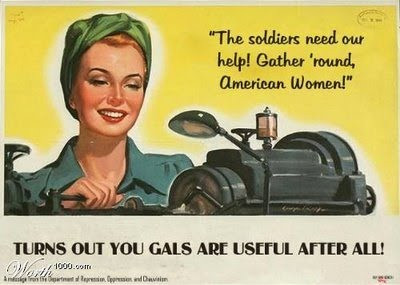
Today I turned on the television, for the sake of this story, and I started skipping through channels. Commercial after commercial I began to look at each one with bewilderment. I was beginning to see something peculiar. “What the hell Carls Jr.?” I had just witnessed a woman in a bikini, dripping sweat, bite into a cheeseburger the size of my head (and I have a huge head). I didn’t know what was more unfathomable. The fact that I just saw softcore porn between commercial breaks for The Big Bang Theory, or the fact that I have never seen a Carl’s Jr. burger look as picture perfect as that in my entire life. At that moment, my stomach started to grumble and my mind couldn’t stop thinking about Carl’s Jr. It was not the actual woman they were selling, but it was the shock-value of seeing such blatant hyper-sexualized imagery of a fast food restaurant. It felt out of this time, like it was a throwback to the past. This led me into wanting to research a very important question. What are the reasons why women are hyper-sexualized in advertising, and how do men compare throughout history? I began my research where most ads started. Magazines in the 1950’s. I also wanted to understand the psychology of sex in advertising and how it translates to sales. This is what I found out.
1950’s -1960’s
Back during the 1950’s when media like mobile phones, internet, and cable tv did not exist, magazines or newspapers were the source of media consumption. It was simpler and by todays context much more detached from modern sensibilities. They were like your grandparents that came over for Thanksgiving and said controversial things at the dinner table, but you knew that they were from a different time, so you keep passing the mashed potatoes and wait for the night to be over. Authors, Terri D. Conley and Laura R. Ramsey claim that most advertisements have trouble empowering women because history shows that women have always been seen as either in positions of defense or being chased[1]. This means that they exist in a medium where they are constantly portrayed as passive towards the male figures domineering or overpowering presence. This especially ties into American history where during a post-World War II era men were returning from war waiting to get back to their regular jobs. Keep in mind, advertisements that ran during the war had encouraged women to take up jobs and support their men at war. In response to the men returning from war, women were rewarded with the opportunity…to give their jobs up to the men and continue to work as secretaries, clerks, telephone operators, or the housewife[2]. Many of us can look at these chains of events towards women as obviously sexist, but back in the day, displacing a man against a woman in a position of dominance was the norm. Women were subjected to be seen as home bodies who were cleaning, baby-making machines who had to step aside for their men to come home. Suffice it to say, men had it pretty good. Excuse me, I used the past tense. I meant “have” with an emphasis on the “h”.
1960’s – 1970’s
As we move forward to the 1960’s-1970’s, prior to the Civil Rights movement of the 1960’s, women’s voices were unheard. With the rise of feminism, men were beginning to feel the heat, but it didn’t stop a male dominant industry from producing overwhelmingly sexist advertisements. Following Hofstede’s masculinity index, authors Jorge Matthes and Michael Prieler state that the state of advertisements at the time was an unspoken connection we made with genders and products[3]. For example, women had been presented in ads along with toiletries, beauty products, and kitchen tools which communicated to the audience that women were domesticated and belonged home. Meanwhile men were often tied with cigarettes, cars, electronics, and telecommunications which were symbols of freedom and independence. Today we have shows like “Mad Men” that give us a peak back at this era, but as we can see from the images above, this important theme of male dominance and unquestionable desire lingered on. It wasn’t until around 1975 that women began speaking up and calling out sexism. What followed was the boom in female empowered advertising that baby stepped its way into mass media. Welcome to the 1980’s.
1980’s – 1990’s
The rise of the 1980’s advertisements introduced a new trend, which was the gender role reversal that took an approach towards dissipating old values of masculinity. Although we can still look back at these ads and see that they are not golden examples of gender equality, it was a response directly to the era that came before it, and it produced discussion on female representation in media. “When Harry Met Sally” introduced a hard-working female lead that knew what she wanted and took control. Women were slowly being seen as icons in athleticism and being presented as strong. However, today as we begin to look back at these ads of the 90’s, by adopting a constructionist approach[4] of analysis, the sexism of advertisements become hidden in plain sight. Through a combination of both Hofstede’s research and the constructionist approach of Stuart Hall, the direct relation of female subordination and male dominance can be witnessed from most of these images alone. Around the 1990’s, this subversion of gender roles and standards were played as humor since at the time it was such a “wacky” concept. “A stay at home dad having to take care of the kids, WHAT A TWIST!” It was not sexism in the classical sense, but subtler to provoke a false sense of female empowerment when in reality men still hold the power.
2000’s – Present
In most recent years, we have discovered as a collective that body image and female identity are closely tied together in marketing. Okay, I lied, they have always been together. However, my point is that many leaps have been made within the beauty industry to be inclusive to body image and type. Take a look at Doves Campaign for Real Beauty that took place in 2004[1]. This was a push by the Dove marketing team to create inclusivity for all women and to encourage to shake the long sentiment that only specific body types can be considered beautiful. This shake up was a result of many women over the past two decades to take up roles of management and directing within marketing. The inclusion of women within many industries gave the power back to them to control what their audience sees. The Dove campaign is a solid example of that concept. If you give an underrepresented group the means to represent themselves, chances are it will be successful. Nevertheless, there will always be bad eggs that prevent the fashion, beauty, and many other industries to be more progressive. Men’s cologne brands such as Dolce & Gabbana and comparatively how men and women model clothing still confides into the composition of male dominance and female subordination. Brands like American Apparel and H&M have also fallen victim not only to their textile industries poor treatment of employees, but for their disproportionate hyper-sexualization of their unisex clothing lines. From the length of this post, you can assume which gender was unfairly represented.


I’ll sign off with the statement that as we have seen industries begin to wake up and identify issues of gender representation, inclusivity in the corporate rungs of female representation have developed new and creative ways of representing women. As a direct result, how men are represented in advertisements has noticed these changes and has also taken a few ideas here and there to develop campaigns that will help dilute toxic masculinity and promote diverse body images. Baby steps have been made, but the future is wrought with opportunity and at this moment we will take all the steps we can take.
Footnotes:
[1] Conley, Terri D., and Laura R. Ramsey. “Killing Us Softly? Investigating Portrayals of Women and Men in Contemporary Magazine Advertisements.” Psychology of Women Quarterly, vol. 35, no. 3, 2011, pp. 469–478., doi:10.1177/0361684311413383.
[2] “Women: Representations in Advertising.” Ad Age, 15 Sept. 2003, adage.com/article/adage-encyclopedia/women-representations-advertising/98938/.
[3] Matthes, Jörg, et al. Sex Roles, Springer US, 2016, http://www.ncbi.nlm.nih.gov/pmc/articles/PMC5023740/.
[4] Hall, Stuart. Representation: Cultural Representations and Signifying Practices. London: Sage in association with the Open University, 1997. Print.
[5] Nielson, Hailey E. “Dove Campaign for Real Beauty.” Eating Disorders: An Encyclopedia of Causes, Treatment, and Prevention, edited by Justine J. Reel, Greenwood, 2013, pp. 147-149. Gale Virtual Reference Library, http://link.galegroup.com/apps/doc/CX2723200058/GVRL?u=wash_main&sid=GVRL&xid=d5bfeed8. Accessed 25 Feb. 2018.
Consumer Culture and the Music Industry

Music has the power to elicit emotion, bring people together, and allow some to connect even cross-culturally. Historically, music has been enjoyed at all kinds of social events and still today it can be difficult to find yourself in public at a restaurant, grocery store, or gym and not hear some kind of music playing. So why is it that music consumption is at an all time high and experiencing such a cultural shift? The Nielsen Music’s 2016 U.S. Year-End Report indicates that entire music industry increased its overall volume of consumption by 3.1% between the 2015 and 2016. The report also shows that online streaming services such as Spotify, YouTube, Apple, SoundCloud, etc. are becoming increasingly influential in driving up those numbers.¹
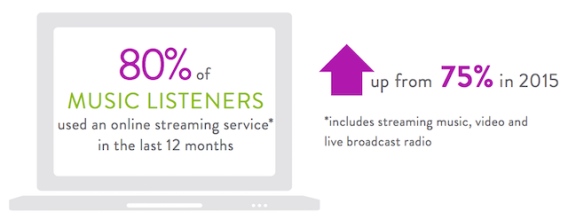
As technology has improved over the past 20 years, so has the way Americans consume music. When smartphones were introduced into the market it allowed for easy mobile access to online streaming services for music. Listeners can experience music in a much different way through services that provide free music streaming while also allowing for more customization rather than popping in a CD and only listening to one artist. According to the Pew Research Center, “77% of Americans now own smartphones” and music consumption seems to be at an all time high with the help of this technological advancement.²
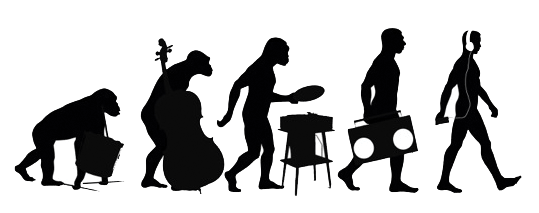
The ability for an individualized user experience is an important factor influencing the changes in the music industry and music consumption, additionally, shifting the way we experience music culturally. A group of people leading this change are millennial’s. According to a report from Digital Music News, millennial’s listen to more music than the generations before them. Streaming services allow for greater interaction with the music they listen to, demonstrating the way music streaming sites are changing and how we listen to music, allowing for greater reach and discovery.³
In an attempt to keep up with the consumer demands for personalization and accessibility, the music industry has shown innovation and responsiveness with apps and services such as Spotify, exemplifying some of the benefits of a market model of media, according to The Business of Media by David Croteau and William Hoynes.4 The algorithm that Spotify works through in order to provide their unique music experience is a great example of why it led the charts with smartphone users in 2014. Robert Prey examines how Spotify works through this algorithmic individuation, operating slightly different than other streaming services because of its use of The Echo Nest.5 In this video, VoxCreative gives a brief summary of how Spotify operates through its algorithm while focusing on “Discover Weekly”, a major way this service connects people and music differently. This technology analyzes a song intensively in order to match it with songs of similar tempo and structure. It also works to develop the user’s music taste profile while engaging on a cultural level by incorporating not only the user’s tastes, but others of similar qualities. Therefore, Spotify’s algorithmic individuation is a process that allows for self-actualization through music consumption habits that eventually form a music identity profile benefiting oneself as well as the service. It can work as a social mechanism to connect users with other people with similar consumer preferences, but also can connect user’s deeper with their own individuation and personal expression.

Music consumption and music sharing as a social process has come a long way since Napster revolutionized the way we culturally interact with music. Spotify is a big player when it comes to this cultural shift in our music consumption habits. The company’s vice-president says that they want to make Spotify more of a ritual where, “You’ll begin to use it for a set of habits, and we will start to feed content into every slot of your day”.6 Because of this shift away from traditional ways of listening to music where you might only have access to one artist at a time on a CD, consumers have abundant access to the world of music without rigid genre constraints. In this way, “streaming services have bred a musical culture that more closely resembles a cocktail buffet than a sit down dinner”7, meaning that we like to sample from the wide variety of musical genres, sounds, and artists that produce music to fit our demands in the present mood. In turn, this creates less loyalty towards artists and more competition between them in pursuit of gaining broad popularity and money. These new interactive media technologies enable a musical world with specific algorithmic innovations which challenge the mass media model of meaning making in the way that it creates potential for new forms of audience participation and a shift in power.8 Music is so embedded in our culture and will continue to be an avenue for societal maintenance, personal expression, validation, and self-realization of our place in this world.
M.M.
Peer Edited by: M.R. & N.H.
Works Cited
[1.] Washenko, Anna. “Nielsen 2016 Report: ‘Music Consumption Is at an All-Time High.’” RAIN News, 9 Jan. 2017, rainnews.com/nielsen-2016-report-music-consumption-is-at-an-all-time-high/.
[2.] “Mobile Fact Sheet.” Pew Research Center: Internet, Science & Tech, 5 Feb. 2018, www.pewinternet.org/fact-sheet/mobile/.
[3.] Danner, Rachel. “Millennials Are Changing the Way Music Is Being Consumed.” The Athennial, 16 Mar. 2017, theathennial.com/millennials-changing-the-way-music-is-being-consumed/.
[4.] Croteau, D. & Hoynes, W. (2006). Media, markets, and the public sphere. The business of media: corporate media and the public interest. (15-40). Thousand Oaks: Sage Publications.
[5.] Prey, Robert. “Nothing Personal: Algorithmic Individuation on Music Streaming Platforms.”Media, Culture & Society, 30 Nov. 2017, doi:10.1177/0163443717745147. https://doi-org.offcampus.lib.washington.edu/10.1177/0163443717745147.
[6.] Manjoo, Farhad. “Spotify Wants Listeners to Break Down Music Barriers.” The New York Times, The New York Times, 3 June 2015, www.nytimes.com/2015/06/04/technology/personaltech/spotify-sees-a-future-where-music-genres-dont-really-matter.html.
[7.] Manjoo, “Spotify Wants Listeners to Break Down Music Barriers”.
[8.] “Media & Society: Production, Content & Participation.” Media & Society: Production, Content & Participation, by Nicholas Carah and Eric Louw, Sage, 2015, pp. 50–51.
Additional readings
Haynes, Jo, and Lee Marshall. “Beats and Tweets: Social Media in the Careers of Independent Musicians.” New Media & Society, 4 June 2017, doi:10.1177/1461444817711404.
Cooper, Lauren. “The Somewhat Stagnant Evolution of Music Consumption, Experience, and Appreciation.” The Independent, 23 Apr. 2014, theindependentmag.org/the-forum/somewhat-stagnant-evolution-music-consumption-experience-appreciation/.
Images
Image 1: https://www.google.com/search?biw=1242&bih=602&tbm=isch&sa=1&ei=VYmhWqK4KdeyjwPitrlw&q=globe+listening+to+music+with+beats+headphones&oq=globe+listening+to+music+with+beats+headphones&gs_l=psy-ab.3…76094.81555.0.81687.24.22.2.0.0.0.112.1686.19j3.22.0….0…1c.1.64.psy-ab..0.0.0….0.dBaF73QHyjo#imgrc=XTAtcPfzLoqoOM:
Image 2: http://rainnews.com/nielsen-2016-report-music-consumption-is-at-an-all-time-high/
Image 3: http://theindependentmag.org/the-forum/somewhat-stagnant-evolution-music-consumption-experience-appreciation/
Image 4: https://www.nytimes.com/2015/06/04/technology/personaltech/spotify-sees-a-future-where-music-genres-dont-really-matter.html
Software’s Ever Evolving Influence on the Music Industry
Every company has built off of another, but in the case of the music industry after Napster, it seems they all built off of an idea. With a growth rate of 14% expected between 2014 and 2019, digital streaming of music is expected to take over the market of downloaded music.1 This should come as no shock to anyone who is an avid consumer of music as most ways to find new artists comes on a digital front. Of these new markets, there have been a few that have taken over as the most prominent companies since the beginning of peer-to-peer music sharing with Napster.

Spotify is a digital music streaming service and has been called “the biggest streaming platform in the world,” having “more than a hundred million active monthly users”.2 Beginning in 2008, Spotify allows the streaming of music from the cloud, removing the necessity to purchase and download music, although they allow for subscriptions and downloads. Despite the fact that the company has had controversies with their paying of artists, the company is in 58 countries and has 60 million active users (as of 2015).3
According to an article by Patrick Vonderau, “[Spotify] is credited with curbing non-authorized forms of file-sharing”2, which was an important step in getting the rest of the music industry on board with digital streaming, something Napster was unsuccessful at achieving. While originally the company struggled financially under their free model, the company was able to grow, creating equilibrium between advertising, technology, music, and finance.2 These early complications led Vonderau to look at the similarities of Napster and Spotify, noting that both used peer-to-peer networks and unlicensed music in their beginnings. However, unlike Napster, Spotify was able to make the shift to legally streamed music and created a profitable digital music sharing business that is now helping to revolutionize the way we listen to music.
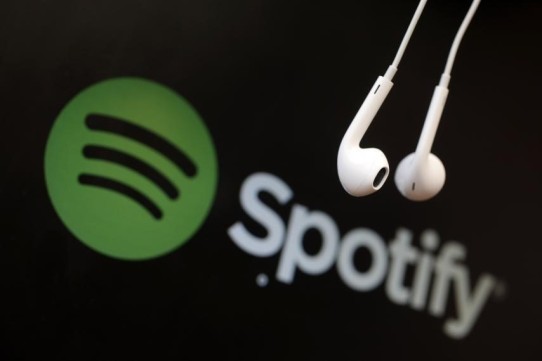
While Spotify is often considered to be one of the most important music streaming services, there have been many to come before it, like Pandora Internet Radio. Unlike Spotify, Pandora is not a streaming service where the user is choosing their own music. Instead it works like a radio, picking music for the user and playing these songs. However, Pandora changes the formula to differ from the usual radio experience. “Pandora’s content-based recommender system is powered by a massive music database called the ‘Music Genome Project’.”4 This project takes notes from what users actively like and dislike on the service and changes the music to adapt to what they might be more interested in. The author continues to state, “[In other words], through continuous feedback, Pandora learns more and more about each listener’s tastes, resulting in a progressively more personalized station”.4 Systems like these are being used and adapted in more and more companies, as is seen with Spotify and their adapting music in the “Discover Weekly” playlists containing music that changes every week with the users listening habits. Personalized music is not necessarily new anymore, but companies seem to continue to be adapting them more and more to create an all-around more personal feeling experience while using algorithms and databases behind the scenes.
An important topic discussed in a chapter from the book The Business of Media by David Croteau and William Hoyness, explains the idea of the “public sphere model”. He notes that a market is not always based on the purchasing power and that “profitability cannot be the sole indicator of a healthy media industry”.5 As mentioned above, Spotify was not originally profitable, but even still they were able to help change the way we consume and find music. Although a profit is needed to maintain a company, I believe it is important to remember that no matter what a company can still make change even before they become prolific, as Spotify has done.
The music industry is shifting, and with it are the applications and software individuals use to get their music. As we continue to progress into a more streaming oriented society of music listeners, we will more than likely see a growth in more “personalized” music. Napster, while in its day was brought down and used as an example of how the music industry would need to stay physical and with the record industry, helped bring into the world the idea that streaming and online music is necessary for consumers. Since then, companies have used their model and created more profitable and more importantly legal businesses that have changed the music industry completely. Whether this is good or bad is for every individual to decide.
N.H.
Peer Edited by: M.R. & M.M.
Works Cited
[1.] Berr, Jonathan. “After Napster, the music industry winds up humming.” Money Watch, CBS News, 12 Feb. 2016, https://www.cbsnews.com/news/after-napster-the-music-industry-winds-up-humming/
[2.] Vonderau, Patrick. “The Spotify Effect: Digital Distribution and Financial Growth.” Television and New Media, 21 Nov. 2017, pp. 1-17. Sage Journals, https://doi-org.offcampus.lib.washington.edu/10.1177/1527476417741200
[3.] Pullen, John Patrick. “Everything You Need to Know About Spotify.” Tech, TIME, 3 June 2015, http://time.com/3906839/spotify-tips/
[4.] Prey, Robert. “Nothing personal: algorithmic individuation on music streaming platforms.” Media, Culture and Society, 30 Nov. 2017, pp. 1-15. Sage Journals, https://doi-org.offcampus.lib.washington.edu/10.1177/0163443717745147
[5.] Croteau, D., & Hoynes, W. (2006). Media, Markets, and the Public Sphere. In The Business of Media: Corporate Media and the Public Interest (pp. 15-40). CA: Pine Forge Press.
Beauty Standards
Every time I flip through a magazine, page after page, I see these “perfect” women. I wish I were one of them. They have no pimples, their skin is perfect, they are young, and they are skinny and sexy. I remember I cut them off and pasted them onto my door, so every time I walk out, it will remind me of being “perfect” like them. These advertisements on magazines create a dissatisfaction with my own body. Being 22 years old woman, every time when I read an advertisement, I’m criticizing my own body, “I’m too fat, I really need to go to the gym; why can’t my pimples go away? Omg! Am I still on puberty?” these voices keep coming into my head as I flip through those advertisements.
Advertisers create a beauty standard for women. When we flip through magazines and ads we can see that only certain types of women are being represented. Their body type is skinny, their skins are lighter, and they are not aging. These advertisements create a hegemonic beauty in the industry. Hegemony is when certain group(s) create, dominate and maintain the power in the industry, in this case, is the advertising industry (Carah & Louw, p23). “Hegemonic messages—to be thin, pretty, White, and young—are reproduced over and over again to sell dissatisfaction to the female consumer.” (Del Rosso, p. 188) Women and girls like me are constantly consuming these message through ads in everyday life and it creates a low self-esteem to women and girls and thinking there is something should be changed about their body (Bahadur). And let’s take a closer look at women’s beauty standards in advertisements.
Body types
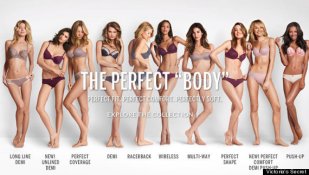

In 2014, Victoria’s Secret featured an ad for their bra called “The Perfect Body” (left image). We can see some common women’s bodies are featured. The models from Victoria’s Secret are all skinny, tall, slim legs, no body hair etc. Compare to a better image to the right, an ad from Dear Kate (an underwear brand) has more diverse and realistic body sizes of women. Companies like Victoria Secret lower women’s self-esteem (Bahadur). The hegemonic beauty standards tend to make women and girls feel unhappy about their own body and they have to do something to fit into the narrow body standards, so companies can easily make a profit out of female consumers. (Del Rosso, p.188)
Skin color
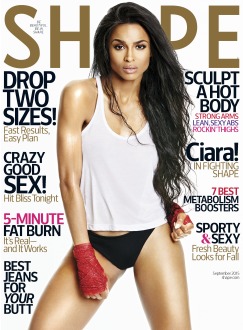
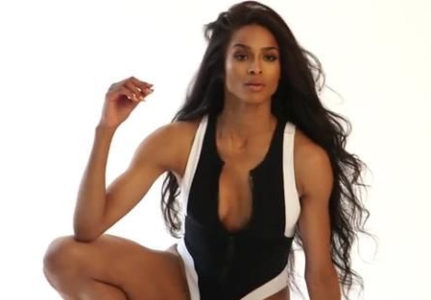
Even though advertisers are trying to improve diversity by incorporating different colors of women in their ads, in a lot of cases, they still tend to lighten the skin of models that have a darker skin tone. For example, Shape Magazine has Ciara as their front page cover model for September 2015 magazine (image left), which it appears a lighter skin tone than Ciara in real life (image on right, without Photoshop). From an article “Skin color shades in advertising to ethnic audiences: The case of African Americans by Stevie Watson said, “Critics have accused the advertising industry, music entertainment companies and magazine publishers of ‘historically capitalizing on the hierarchy of skin color that often exists among AAs’ [African American] by frequently portraying light-skinned AA female models as the standard of ethnic beauty and allegedly using digital lightening techniques on darker-skinned AA female models in print ads (p 186).” Ciara appears to be dark skin in the magazine, but it’s never her real skin color. Advertisements nowadays have models of diverse backgrounds than before. There are more Asian, African American, and Latina models posing for these ads. However dark skin women in ads are usually whiter than they actually are.
Aging


When people get older we start to get those wrinkles on our eyes and loose skin on our face and body. It’s human nature if we have those because everyone is expecting it and will experience it through their lives. But women and aging in advertisement industry are usually portrayed as a terrible thing. When we turn on the TV or open up magazines you can often see those “smile with no wrinkles, join me and look young” women anti-aging ads. Advertisers build the message of “aging equal ugliness” for women audiences, so they have products to sell (p.188). Women in aging are represented as ugly, but on the other hand, men and aging are a different story. If we compare mid forty celebrities Julia Roberts (45 years old on an ad for Lancome La Vie Est Belle perfume in 2014) and Patrick Dempsey (43 years old for an ad for his own magazine in 2009) together, you can see Julia seems fake-ish as a mid forty years old woman as Patrick appears more realist in his age.
As an Asian woman, even though I’m young but I don’t fit into these beauty standards. And being “young” can’t stay forever. Before taking this class, I didn’t know the influence of an ad can affect me in this many ways, I was unconsciously consuming these messages in my everyday life. And being frustrated and disappointed with my own body. This is not how I should feel and how any other women should feel about themselves. How advertisers advertise women in ads are wrong. The message of women should be “skinny, lighter skin and young” are not acceptable. This is not women should be portrayed and be represented in ads. Any women and girls out their should be aware of this hegemonic beauty and should be confident in who they are and how they look.
Work Cited:
Bahadur, Nina. “Victoria’s Secret ‘Perfect Body’ Campaign Changes Slogan After Backlash.” The Huffington Post, TheHuffingtonPost.com, 6 Nov. 2014, http://www.huffingtonpost.com/2014/11/06/victorias-secret-perfect-body-campaign_n_6115728.html.
Carah, Nicholas, and Eric Louw. Media and Society: Production, Content and Participation. Sage, 2015.
Del Rosso, Teri (2017) “There’s a cream for that: A textual analysis of beauty and body-related advertisements aimed at middle-aged women”, Journal of Women & Aging, 29:2, 185-197, DOI: 10.1080/08952841.2015.1125698
Watson, Stevie, et al. “Skin Color Shades in Advertising to Ethnic Audiences: The Case of African Americans.” Journal of Marketing Communications, vol. 16, no. 4, Sept. 2010, pp. 185-201. EBSCOhost, doi:10.1080/13527260802707585.
